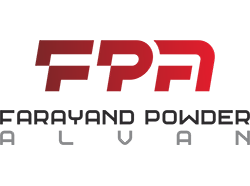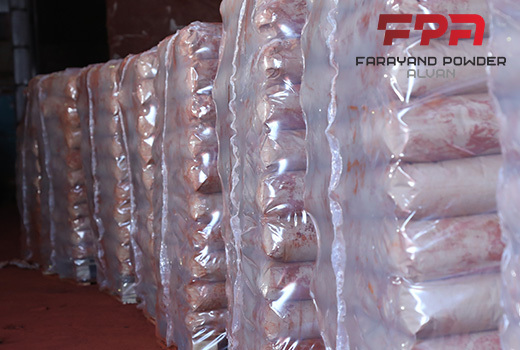Synthetic red iron oxide is prominent in the world of pigments and colorants. This versatile and vibrant compound is crucial in various industries, from construction to cosmetics. Want to know more about What is synthetic red iron oxide? Stay with Farayand Powder Alvan in this article to learn more about the substance and its importance.
Synthetic red iron oxide formula
synthetic red iron oxide pigment is a favored coloring agent across various industries. It undergoes precise chemical procedures to maintain consistent color and high-quality standards. Its durability and resistance to heat and fading make it an ideal choice for coatings, paints, plastics, and ceramics. Synthetic red iron oxide typically exists as fine powder particles, so it has no distinct macroscopic shape. However, the synthetic red iron oxide formula can be described as follows:
Iron atoms (Fe) are bonded to oxygen atoms (O) in a lattice structure, forming a three-dimensional arrangement. The arrangement of atoms in this crystal structure contributes to the compound's color and properties.
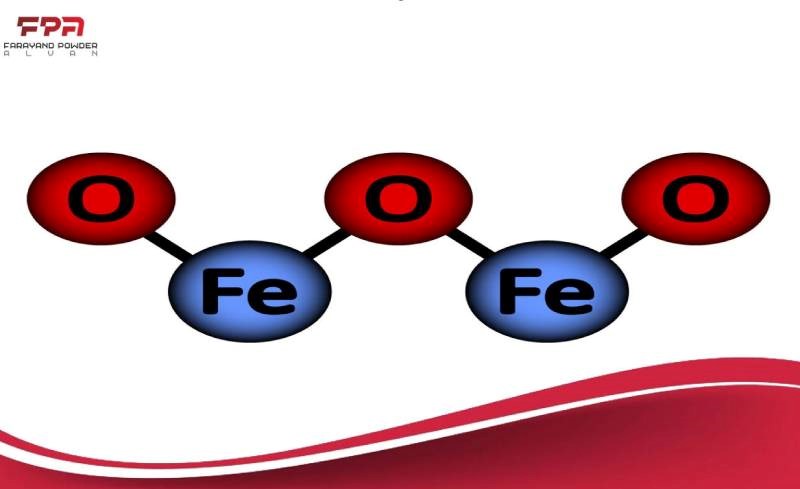
Synthetic red iron oxide benefits
Familiarity with synthetic red iron oxide benefits is another requirement for people working with these materials. Because of this, we mention some of the benefits in this section.
Color Stability
Its remarkable color stability is A significant benefit of synthetic red iron oxide. It maintains its bright red shade even in harsh environmental circumstances, like exposure to UV radiation and extreme temperatures. This makes it a top choice for applications where color preservation is crucial, such as automotive coatings and outdoor paints.
Non-toxic and Environmentally Friendly
Red iron oxide, made synthetically, is a product that's both eco-friendly and non-toxic. It's free from hazardous heavy metals, making it safe for consumer goods like cosmetics and food packaging. Its eco-friendliness is a significant factor contributing to its widespread usage.
Chemical Inertness
This specific pigment is chemically inert, implying it won't react with any other substances it may encounter. This is a significant characteristic in scenarios like construction materials and concrete, where the pigment should not alter the material's properties.
High Tinting Strength
Synthetic red iron oxide has a high tinting strength, requiring less pigment for significant coloration and leading to cost savings for manufacturers.
Cost-Effective
Synthetic red iron oxide is a cost-effective pigment with high tinting strength and color stability, making it a better alternative to many organic pigments.
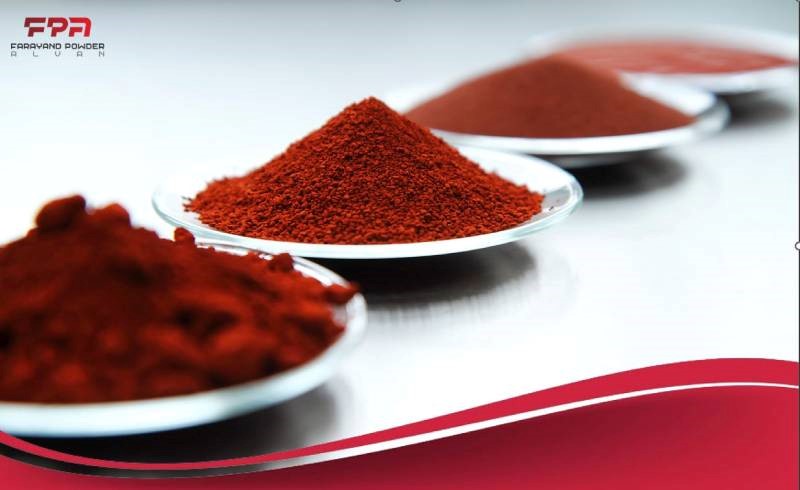
Composition and Properties of Synthetic Red Iron Oxide
In this section, we will introduce the properties of Synthetic Red Iron Oxide's composition.
- Color: Synthetic red iron oxide is famous for its long-lasting and vivid red hue, as it remains stable even when exposed to light and environmental factors.
- Pigment Stability: This pigment is highly stable, making it suitable for various applications. It can withstand UV radiation, heat, and chemicals, retaining long-lasting color.
- Particle Size: The particle size of synthetic red iron oxide can vary depending on the manufacturing process. Smaller particle sizes result in better dispersion and color consistency in various applications.
- Heat Resistance: It is suitable for high-temperature processes, such as ceramic and glass manufacturing, due to its excellent heat resistance.
- Magnetic Properties: Iron oxide has coloration and magnetic properties, making it useful in specific applications.
Uses of synthetic Red Iron Oxide
Synthetic red iron oxide uses are common in many industries. Let's check it out: Why do we need synthetic red iron oxide?
Construction and Architecture
Synthetic red iron oxide is commonly utilized in construction and architecture for its rich red pigment. It is frequently added to concrete, paving stones, and bricks to enhance their visual appeal. This versatile material is highly opaque and UV-resistant, making it an excellent choice for improving the appearance and durability of building structures.
Art and Design
In art and design, synthetic red iron oxide plays a crucial role as a pigment in various media. Artists utilize it in paints, pastels, and colored pencils to create vibrant red hues. Its ability to mix well with other pigments enables artists to achieve a broad spectrum of colors, from subtle earthy tones to bold and striking red.
Automotive Industry
The automotive industry also relies on synthetic red iron oxide for pigmentation. It is used in manufacturing automotive paints and coatings to give vehicles distinctive red colors. Furthermore, it contributes to the corrosion resistance of the vehicle's metal parts, extending their lifespan and ensuring the vehicle's safety and reliability.
Cosmetics and Personal Care Products
In cosmetics and personal care products, synthetic red iron oxide is crucial. It colors various products, including lipsticks, blushes, eyeshadows, and nail polishes. Its safety and non-toxicity make it a preferred choice for formulators looking to create attractive cosmetic products.
Synthetic red iron oxide side effects
Synthetic red iron oxide side effects, like this product's benefits and use, are also significant. You can reduce the side effects of this substance by following the safety tips. But we mention them here.
Skin Irritation
In rare cases, individuals with hypersensitive skin may experience mild skin irritation when exposed to synthetic red iron oxide products. This can manifest as redness, itching, or a rash. It's crucial to perform a patch test before using such products to identify adverse reactions
Allergic Reactions
Some people may develop allergic reactions to synthetic red iron oxide, leading to more severe skin symptoms such as hives, swelling, or dermatitis. Individuals with a history of allergies should exercise caution when using products with this pigment.
Inhalation Risks
Workers in industries where synthetic red iron oxide is used in powder form (e.g., paint manufacturing) should be cautious about inhaling the pigment, as prolonged exposure to airborne particles can lead to respiratory issues like coughing and lung irritation.

Buy Synthetic red iron oxide from the best manufacturer
To choose the best synthetic red iron oxide manufacturer, consider the following factors:
Quality: Look for a manufacturer that produces high-quality synthetic red iron oxide. Check their website for information on their manufacturing process and quality control measures.
Certifications: Choose a manufacturer that has certifications like ISO 9001, which ensures that the manufacturer has a quality management system in place.
Reviews: Check reviews of the manufacturer online, including on their website and other online marketplaces like Amazon. Look for positive reviews that mention the quality of their products and customer service.
Price: Compare the prices of synthetic red iron oxide offered by different manufacturers. Keep in mind that the cheapest option may not always be the best quality.
Customer service: Choose a manufacturer that provides excellent customer service. Look for a manufacturer that is responsive to customer inquiries and provides helpful information.
Availability: Choose a manufacturer that has a reliable supply of synthetic red iron oxide. Check their website for information on their inventory and lead times.

the important points for buying synthetic red iron oxide
After learning about what is synthetic red iron oxide and checking what is synthetic red iron oxide used for, we need to know what factors we should follow to choose and buy the best synthetic red iron oxide product.
1. Product Specifications
Before making a purchase, carefully review the product specifications provided by the manufacturer. Ensure that the synthetic red iron oxide meets the required standards for color strength, particle size distribution, chemical composition, and other relevant parameters. These specifications directly impact the pigment's performance and suitability for specific applications.
2. Purity and Consistency
Consistency is crucial when it comes to achieving the desired color in the final product using synthetic red iron oxide. High purity levels and minimal impurities contribute to color stability and durability. It is essential to look for products that offer these characteristics to ensure consistency in color across different batches. This will help you avoid unwanted variations in the final product.
3. Particle Size Distribution
The quality of synthetic red iron oxide depends on the size of its particles. A smaller particle size leads to better dispersion, stronger tinting and more uniform coloring. On the other hand, larger particles may result in reduced tinting strength and uneven coloring. Therefore, it is recommended to choose a product that has a well-controlled and consistent particle size distribution for achieving optimal results.
4. Color Stability and Lightfastness
Assess the color stability and lightfastness of the synthetic red iron oxide, especially if it will be exposed to sunlight or other environmental factors. High-quality pigments should exhibit good resistance to fading and color change over time, ensuring the longevity of the colored product.
5. Application Compatibility
It is important to carefully consider the intended applications for the synthetic red iron oxide and ensure that the chosen pigment is compatible with the materials and processes involved. Different industries may have specific requirements, and selecting a pigment that is tailored to those needs is essential for achieving the desired results.
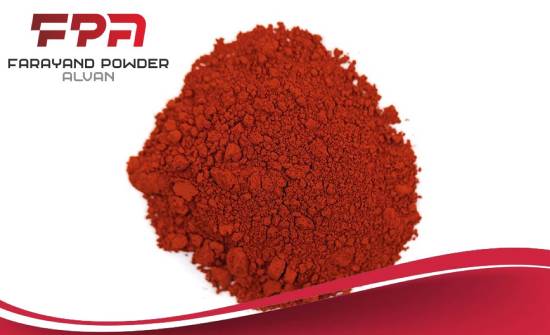
6. Regulatory Compliance
Check whether the synthetic red iron oxide complies with relevant regulatory standards and guidelines, such as those set by environmental agencies or international organizations. Regulatory compliance is crucial for meeting industry standards, reducing environmental impact, and avoiding potential legal issues.
7. Manufacturer Reputation
It's important to choose a reputable and reliable manufacturer with a history of producing high-quality synthetic red iron oxide. Research the manufacturer's certifications and customer reviews to gauge their commitment to quality and customer satisfaction.
8. Pricing and Cost Considerations
While price is a significant factor, it should not be the sole consideration. Compare prices from different suppliers and consider the overall value, including product quality, consistency, and customer support. Cheaper options may compromise pigment quality, leading to potential issues in the final product.
9. Packaging and Handling
Evaluate the packaging of the synthetic red iron oxide to ensure it prevents contamination, moisture ingress, and other factors that could affect the pigment's performance. Adequate handling instructions and precautions should be provided to ensure the safe and effective use of the product.
10. Technical Support and Customer Service
Choose a supplier that offers excellent technical support and customer service. Access to knowledgeable professionals can be invaluable in addressing issues, providing guidance on optimal usage, and resolving concerns related to synthetic red iron oxide.
Conclusion
Synthetic red iron oxide has left an indelible mark on various industries with its vibrant colors and versatile properties. Its role in construction, cosmetics, and art is undeniable. As we move forward, responsible usage and continued innovation will ensure that this remarkable pigment thrives.
With over 30 years of experience in producing various industrial micronized powders and an experienced team with extensive knowledge of pigments, Farayand Powder Alvan Co. has been a reputable supplier in various industries and is honored to provide technical consultation to customers for the best and most economical solutions.
